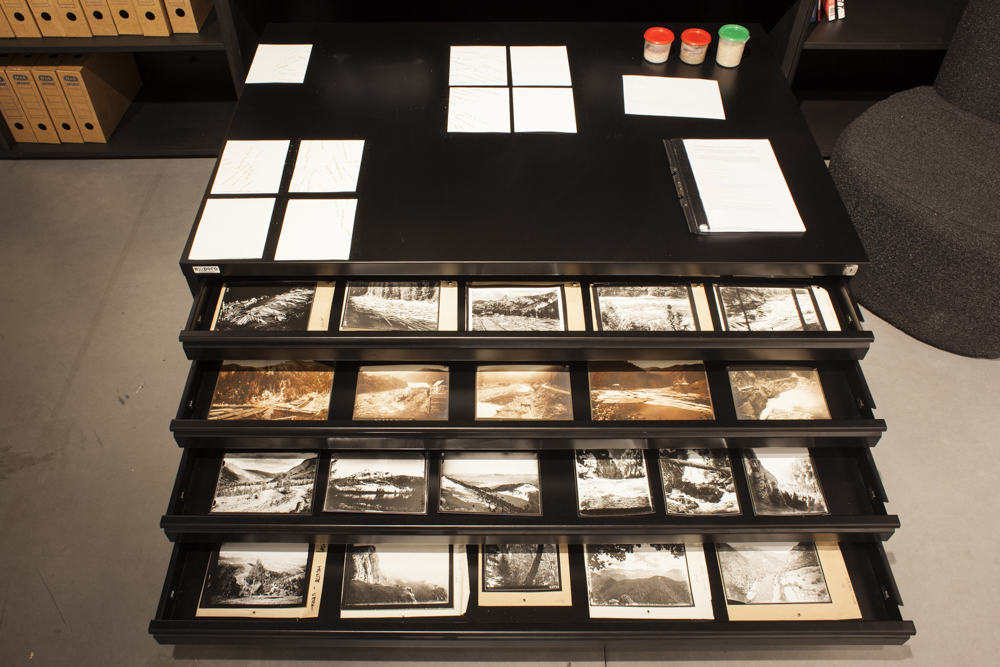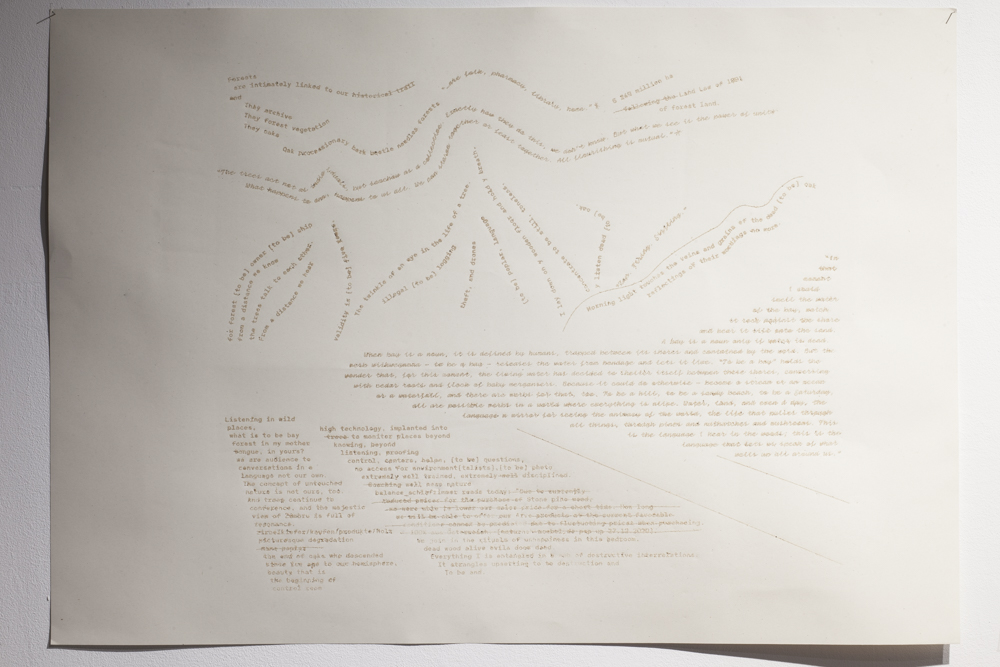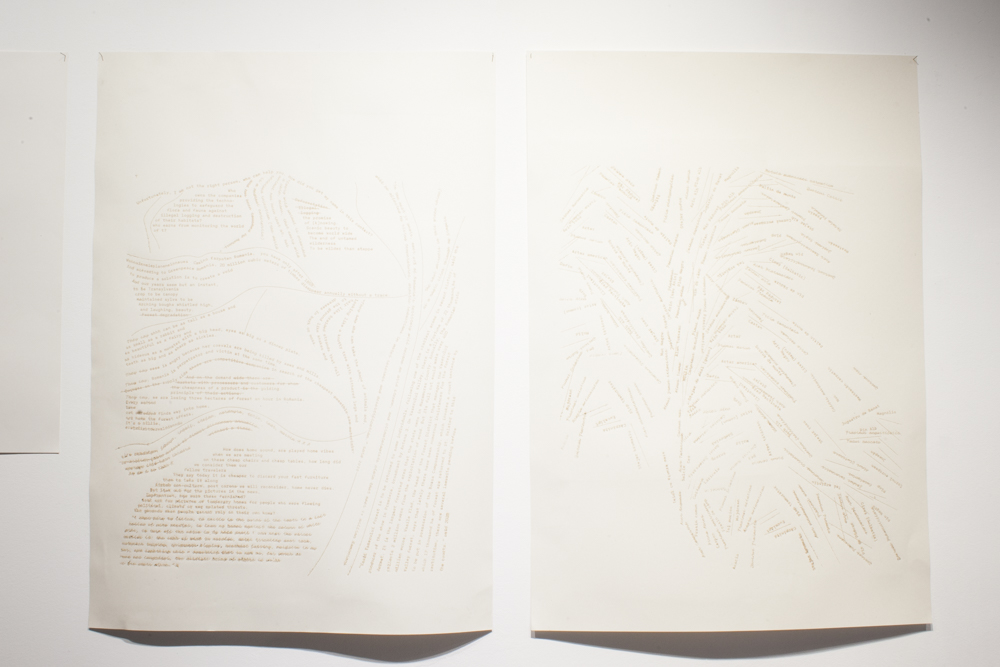Artist Talk
Wednesday, January 13, 2021 / 19.00
Live on Salonul de proiecte’s YouTube channel
Artistic intervention in the EXPO_01_BUC_ARH_SP.PUBLIC exhibition
January 13 – February 07, 2021
Wednesday – Sunday / 15.00 – 19.00
Salonul de proiecte
Palatul Universul, Building B, 1st floor, Actor Ion Brezoianu 23–25, Bucharest, Romania
The third artistic intervention in the EXPO_01_BUC_ARH_SP.PUBLIC exhibition proposes a critical approach to the phenomenon of deforestation, from the viewpoint of artist Susanne Kriemann. For this occasion, she has realised a visual essay that will be distributed to the public free of charge, produced by means of silk screen printing, which in this case employs a pigment extracted from fragments of discarded Ikea furniture. The essay combines information from various sources: lines from poems and folk rituals interspersed with quotations from local and international press and academic articles, which discuss the future prospects of Romania’s virgin forests in the European context. The texts are accompanied by a selection of images from the Mihai Oroveanu Image Collection, which present idyllic forests untouched by human hand and, by contrast, the lumber industry in Romania at the beginning of the twentieth century. These photographs point to a connection with the current situation, in which we are witnessing large-scale illegal logging over vast forested areas of the Carpathian Mountains, a process driven by the European market’s demand for raw lumber, a market dominated by the economic interests of giants such as the Inter Ikea Group.
In this project, Susanne Kriemann continues her complex investigations analysing the effects of industrial exploitation on the natural environment, while at the same time inventing sophisticated means of producing images capable of conveying the microclimatic and geological transformations of areas subjected to processes of readaptation and re-sedimentation of their constituent materials. Kriemann is interested in the interconnected phenomena of the global economy, which have a profoundly destructive knock-on effect at various vulnerable points, but she is equally concerned with drawing attention to multimillennial natural areas, which once stretched over vast transnational territories and which are now greatly diminished and at risk of complete destruction. Such is the case of the Ancient and Primeval Beech Forests of the Carpathians, Europe’s last virgin forests, which also survive within the borders of Romania, an environment that nurtures us humans as well as an incredible variety of plants and animals.
The work in process is co-produced with Cristina Moreno Garcia (research), Grigore Liteanu (silk screen printing, pigment production) and Isabel Motz (design).
If you are interested in the topic, please write a letter to studiokriemann.production@gmail.com and share your words, sounds, memories, dialogues, and ideas with Susanne and the world of forests.
As part of her artistic work, Susanne Kriemann (b. 1972) examines socio-historical processes. Field work, archival research and experiments with technology and material lead to a way of working in which analog and digital practices are inextricably linked and reflect one another. Recent exhibitions include: Susanne Kriemann, Reconsidering Photography: Underbrush, Museum für Kunst und Gewerbe Hamburg (2021/2021), Fragile Times, Galerie im Körnerpark, Berlin (2020) and “(In) finite resources?” Artistic Positions Since the 1980s, Städtische Galerie Karlsruhe (2020). Since 2017 Susanne Kriemann is a Professor for Media Art and Photography at Karlsruhe University of Arts and Design. / www.susannekriemann.info
The exhibition EXPO_01_BUC_ARH_SP.PUBLIC / A selection from the Mihai Oroveanu Image Collection imagines an elliptic journey through various layers of Bucharest’s architecture, suggesting a more comprehensive understanding of the public space, of which single buildings represent only a small part. This decision was dictated by our own emplacement, as well as by the vast presence of images on this topic within the collection; the selection has been guided by the intention to construct a wide-ranging view—however fragmentary—of an urban space in transformation. The series of exhibited photographs seek to be at odds with various stereotypes of representation, to move away from the centre toward the margins, to make visible broader social categories, and to bring to attention the network of public services that make up the metropolis’s hidden “nervous system”.
The exhibition can be visited until February 7, 2021, the guided tours will be announced in advance on social media.








